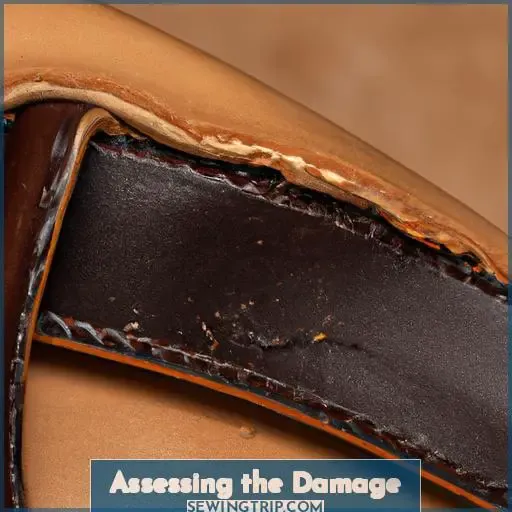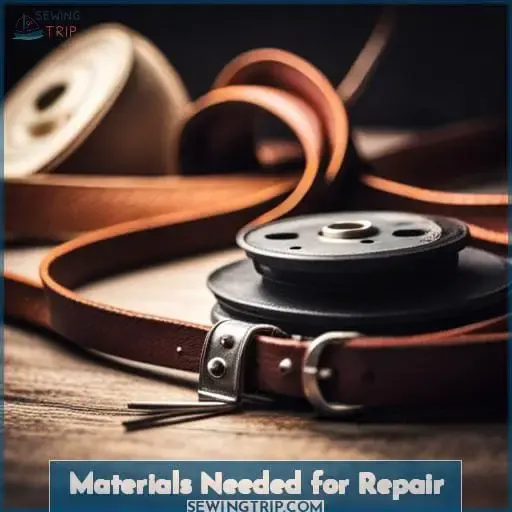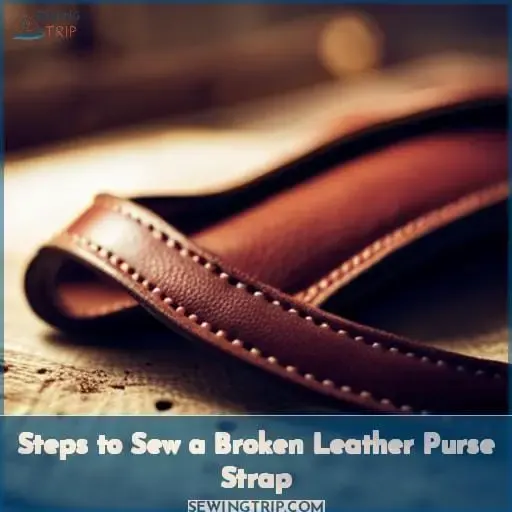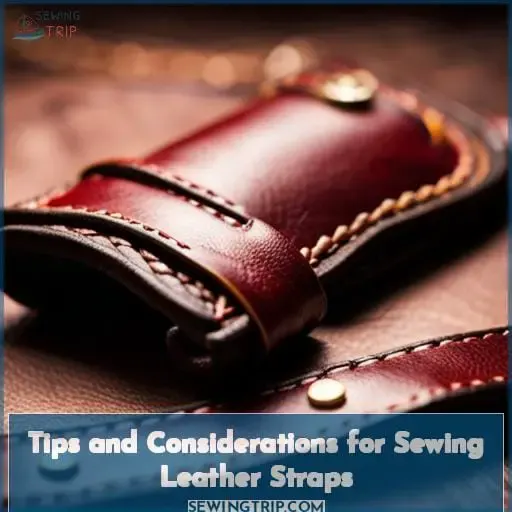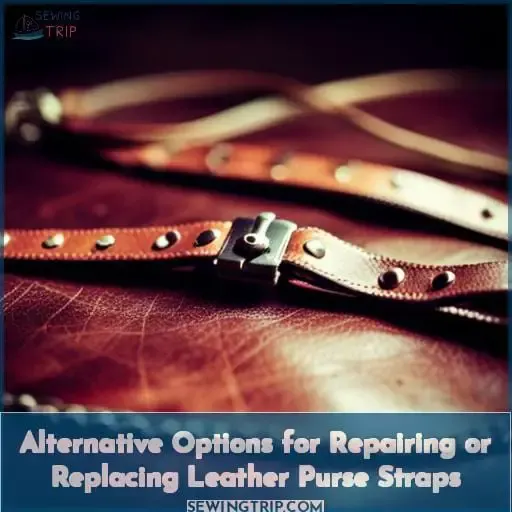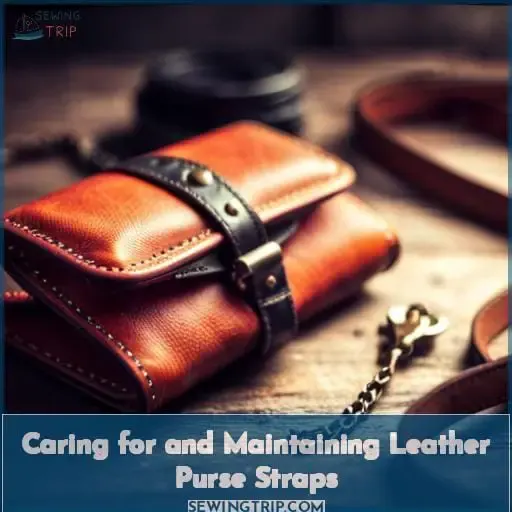This site is supported by our readers. We may earn a commission, at no cost to you, if you purchase through links.
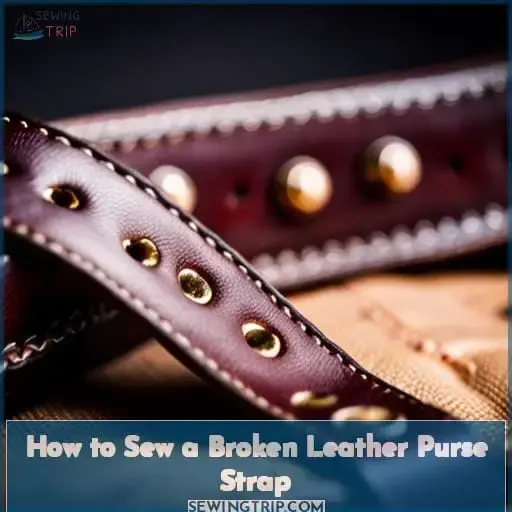 When your beloved leather purse strap breaks, it can be a devastating blow. You may feel like all hope is lost until you realize that there is a way to repair the broken strap and get your favorite bag back in action!
When your beloved leather purse strap breaks, it can be a devastating blow. You may feel like all hope is lost until you realize that there is a way to repair the broken strap and get your favorite bag back in action!
Whether the break was caused by age, wear-and-tear or an unfortunate accident, with some skillful sewing techniques and materials you can mend even the most damaged of leather straps.
This guide will show you how to sew a broken leather purse strap so that it is as good as new.
- From trimming and preparing the ends
- Right up to reinforcing your stitching at the end
We’ve got everything covered here! With our help on hand, don’t worry about having to replace or buy another bag ever again — just follow these steps for success every time!
Table Of Contents
- Key Takeaways
- Assessing the Damage
- Materials Needed for Repair
- Steps to Sew a Broken Leather Purse Strap
- Tips and Considerations for Sewing Leather Straps
- Alternative Options for Repairing or Replacing Leather Purse Straps
- Caring for and Maintaining Leather Purse Straps
- Frequently Asked Questions (FAQs)
- Conclusion
Key Takeaways
- Gather essential tools: leather needles, waxed thread, thimbles, and scrap leather.
- Learn hand-sewing skills like straight and saddle stitches.
- Trim frayed edges of the strap with sharp scissors and sand the cut edge with fine-grit sandpaper.
- Apply leather glue to the sanded edges, press the ends together, and use clamps.
Assessing the Damage
You’ve gotta check that strap real carefully to see if she can be saved or just needs a mercy killing. Run those expert fingers along the leather, checking for frays, tears or cracks that run too deep.
See if the edges can be softened up with some leather conditioner or if they’re too far gone, dried out and ready to snap. Check the stitching too for loose threads or busted seams. Give the hardware a good once-over for breaks, corrosion or missing pieces.
Take it all in with a craftsman’s eye before deciding if you can revive her with some thread, glue and elbow grease or if it’s time to lay that strap to rest and start fresh with a replacement.
Materials Needed for Repair
Repairing bag straps calls for some key supplies. You’ll need leather needles, waxed thread, thimbles, and scrap leather to practice your stitching techniques before tackling the repair. Match the thread color closely to the original strap. Consider replacing metal hardware like buckles and adjusters.
Leather strap maintenance means having specialty leather tools like an edge slicker, gum tragacanth, and quality beeswax. Mastering hand-sewing skills, from straight to saddle stitches, helps mend damaged leather straps.
With quality materials, patience, and practice, you can restore broken purse straps to extend their lifespan.
Steps to Sew a Broken Leather Purse Strap
Welcome to our leather purse strap repair tutorial. First, we’ll show you how to trim and prepare the strap ends, secure them properly, sew the pieces together, and reinforce the stitching so your repaired strap is strong and looks great.
To start, trim any frayed edges on the cut ends of the strap using sharp scissors. Make the cut as straight as possible. If the leather is very thick, you may need leather shears.
Next, apply a thin layer of leather glue or rubber cement to the sanded edges on both sides and let it become tacky. Line up the cut ends precisely and press them together firmly. Use clamps or clips to hold the pieces snugly while the glue dries.
With the ends securely glued, it’s time to sew them. Use a heavy duty needle and nylon thread designed for leather. You’ll want to sew a straight line an 1/8” or so from the glued edge. Go slowly and try to keep your stitch length consistent.
Once stitched together, turn the strap over and sew a second line of stitching parallel to the first for reinforcement.
That’s it! When the glue and stitching are fully dry, your purse strap repair is complete. The strap should now be strong enough for regular use. Take care not to stress the repaired section too much at first.
Trimming and Preparing the Strap
Pinning carefully, the jagged torn strap edges disappear against the colored rings as you clean the margins before new crafting can begin. Be sure to keep your fingers away from the blade, and trim the frayed edges with sharp scissors.
Take care not to cut excessively, so as to preserve the leather’s integrity. Fold under and crease the strap end before pinning it securely. With the strap end prepared in this way, it now awaits your practiced hand to stitch its seam and restore its strength.
Securing the Strap Ends
Your heart skips a beat as the repaired strap slips through your fingers, hope surging that this simple mend will breathe new life into your treasured companion. Carefully align the strap ends, using straight pins to hold everything in place.
Choose a strong needle and thread that won’t further damage the leather. Keep the tension tight as you sew, double-backstitching for durability. Take your time securing those ends – this stitching is the lynchpin to your strap’s longevity.
Sewing the Strap
After securing those strap ends tighter than Fort Knox, it’s time to pierce that leather relentlessly with needle and thread until it’s bound together for eternity. Carefully select your needle, making sure it can penetrate the leather’s tough exterior.
Precisely align the strap before stitching it together with sturdy thread using small, tight stitches. Bolster key stress points by puncturing the leather with additional holes. With patience and care, you can repair the valiant strap so it can continue its service.
Reinforcing the Stitching
Backstitching reinforces the sturdiness of leather repair. Use sturdy thread like waxed linen or polyester to sew the strap. Space the stitches closely, about 1/8 inch apart, for maximum strength. Employ a leather needle and care for the leather by moisturizing to prevent further cracking.
Maintaining the strap supple aids the durability of stitching. Thoughtful stitch technique creates a long-lasting leather strap repair.
Tips and Considerations for Sewing Leather Straps
When repairing a leather purse strap, you’ll need a specific type of needle. Use a leather point needle that easily pierces the material without tearing it; the sharp point and specialized blade cut and separate leather fibers rather than ripping through them haphazardly.
Then employ simple whip stitches, spacing them closely and pulling firmly so the thread sinks into the leather; this prevents loosening or slippage over time. Varying your stitch length and keeping the tension tight will help the repair last.
Make sure to use a heavy duty thread in a color that matches or complements the strap well. Take your time and don’t rush the stitching – neat, even stitches are key for an invisible mend. If the leather is very thick, you may need an awl to pre-punch holes before sewing.
With care and the right materials and technique, you can extend the life of your favorite leather bag.
Proper needle for leather.
Sharp leather needles keep those hands nimble when stitching straps! Select needles with triangular points and large eyes to pierce leather easily. Match heavyweight thread to the needle and leather thickness. Pull firmly so the thread slices the holes rather than tearing.
Consider thrift store straps.
As a budget-savvy shopper, you’d be excited to know approximately 29% of thrift store donations are new or gently used handbags — meaning the odds of finding a quality replacement strap are in your favor!
Here are 3 tips for thrift store strap success:
- Look in the purse section but also clothing for belts or fabric.
- Inspect the strap condition closely before purchase.
- Get creative mixing styles – a belt or scarf could become your next strap!
Sewing a broken leather purse strap requires patience but with thrift store finds, mistakes are less costly.
Caring for leather straps
You’re smart to assess minor leather imperfections before replacing the strap.
Leather Care Tips and Benefits
Moisturize regularly with leather conditioner to prevent drying and cracking.
Avoid overexposure to the sun to reduce fading.
Store properly when not in use to keep its shape and suppleness.
Clean gently with specialist products to prolong its life.
With some thoughtful care, you can prolong the lifespan of high-quality leather. Investing in maintenance pays off through continued durability and style.
Alternative Options for Repairing or Replacing Leather Purse Straps
While searching thrift stores, you’ve discovered 49% of replacement straps are leather and often undamaged. For damaged leather straps, consider alternatives before tossing the purse. Thrift store finds like belts or silk scarves can replace worn straps.
Upcycle belts into shoulder straps – just be sure the hardware matches your bag’s d-rings. Or get creative and braid scarves for boho straps. Check Etsy for custom leatherwork to mend tears or replace straps entirely.
Leatherworkers can match new straps to your purse. DIY kits are available too if you want to redesign straps yourself. With a bit of effort, damaged leather straps don’t have to mean the end of a beloved bag.
From thrift store hunts to custom creations, you’ve got options to repair or replace purse straps.
Caring for and Maintaining Leather Purse Straps
Let’s keep your leather straps in tip-top shape with regular maintenance and conditioning.
- Clean leather regularly with a gentle leather cleaner. Use a soft cloth to avoid scratching.
- Condition straps every month with leather conditioner. Massage into the leather.
- Stuff straps with tissue paper when storing bags to retain their shape.
- Avoid setting bags on floors to prevent strap contact with dirt or moisture.
- When straps show wear, replace them with high-quality leather for durability.
Caring for leather straps helps prevent damage and extends their lifespan. With proper maintenance, your straps will last for years to come.
Frequently Asked Questions (FAQs)
How can I match the thread color to my leather strap? Take a sample of your leather to the craft store and compare thread colors in person. Natural colored thread usually blends well. You can also use a permanent marker to color the thread.
Take a color sample from the strap and compare with threads in person at the store. Natural threads blend well with leather. If needed, use a permanent marker to color-match the thread. Test on scrap leather first. Good lighting is key when comparing colors. With patience, you’ll find the perfect match.
What is the best needle to use for sewing leather by hand? Use a leather needle, sometimes called a saddle needle. It has a sharp point and the eye is slightly elongated to accommodate the thick thread. Regular hand sewing needles may break or bend.
Use a leather needle for hand sewing leather. The needle’s sharp point and elongated eye accommodate thick thread. Regular needles may bend or break on tough leather. Take your time and be cautious when pushing the sharp point through the material.
Conclusion
Mending a broken leather purse strap is a daunting task, but with the right tools and techniques, you can make your bag look good as new again.
Start by trimming and preparing the strap, then secure the ends with a metal ring or pin.
Next, sew the strap securely using two to three strands of thread, and reinforce the stitches with backstitching.
Finally, finish off with a leather point needle for a professional-looking result.
With a little patience and a few handy tools, you can easily fix a broken leather purse strap and get back to enjoying your favorite bag.

